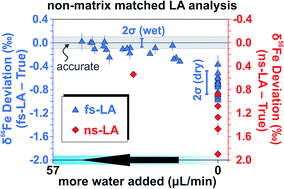当前位置:
X-MOL 学术
›
J. Anal. At. Spectrom.
›
论文详情
Our official English website, www.x-mol.net, welcomes your
feedback! (Note: you will need to create a separate account there.)
Assessment of matrix effects associated with Fe isotope analysis using 266 nm femtosecond and 193 nm nanosecond laser ablation multi-collector inductively coupled plasma mass spectrometry
Journal of Analytical Atomic Spectrometry ( IF 3.1 ) Pub Date : 2017-11-02 00:00:00 , DOI: 10.1039/c7ja00272f Xin-Yuan Zheng 1, 2, 3, 4, 5 , Brian L. Beard 1, 2, 3, 4, 5 , Clark M. Johnson 1, 2, 3, 4, 5
Journal of Analytical Atomic Spectrometry ( IF 3.1 ) Pub Date : 2017-11-02 00:00:00 , DOI: 10.1039/c7ja00272f Xin-Yuan Zheng 1, 2, 3, 4, 5 , Brian L. Beard 1, 2, 3, 4, 5 , Clark M. Johnson 1, 2, 3, 4, 5
Affiliation

|
This study evaluated matrix effects during Fe isotope analysis using a 266 nm femtosecond (fs) laser and a 193 nm nanosecond (ns) laser coupled to a multi-collector ICP-MS. During 150 second spot analysis on pyrite, Fe isotope fractionation was not observed for fs-laser ablation (fs-LA), but was evident for ns-LA. The observed downhole Fe isotope fractionation during ns-LA is caused by multiple processes comprising ablation, transport, and ionization in the ICP. Contrary to the common perception of “matrix-free” analysis, matrix effects clearly exist during fs-LA analysis; small deviations of up to ∼0.2‰ in the measured 56Fe/54Fe ratios from the true value of magnetite grains with ≥∼8 wt% impurities were resolved using a nearly pure magnetite as the bracketing standard. Moreover, inaccurate and imprecise 56Fe/54Fe results were obtained when magnetite and pyrrhotite was measured against a non-matrix-matched standard (pyrite or Fe metal). The observed matrix effects during fs-LA cannot be explained by formation of a large heat-affected zone during ablation, but result from the influence of different chemical compositions of samples and standards on space-charge effects in the ICP-MS. Such matrix effects can be largely suppressed by water addition during analysis at a price of reduced sensitivity, so that precise and accurate Fe isotope analysis to a ∼0.1‰ level can be routinely achieved under “wet” conditions without matrix-matching between sample and standard. These results may reconcile dramatically different precisions previously reported for Fe isotope analysis by fs-lasers, and also highlight fs-LA-MC-ICP-MS as an appealing option for in situ Fe isotope analysis on samples with complex matrices and high-symmetry minerals, both of which encounter significant analytical difficulties using secondary ion mass spectrometry (SIMS). For ns-LA, in addition to similar composition-related matrix effects experienced by fs-LA in the ICP, matrix effects also originate from ablation-related processes that produce sample particles with matrix-dependent size distributions and, often, larger aerodynamic sizes, resulting in highly inaccurate 56Fe/54Fe results during non-matrix-matched analysis under “dry” conditions. The collective matrix effects during Fe isotope analysis by ns-LA cannot be fully suppressed by water addition, therefore, matrix matching is required for accurate Fe isotope analysis by ns-LA.
中文翻译:

使用266 nm飞秒和193 nm纳秒激光烧蚀多收集器电感耦合等离子体质谱法评估与Fe同位素分析有关的基质效应
这项研究使用耦合到多收集器ICP-MS的266 nm飞秒(fs)激光器和193 nm纳秒(ns)激光器评估了Fe同位素分析过程中的基质效应。在黄铁矿上进行的150秒点分析中,未观察到fs-激光烧蚀(fs-LA)的Fe同位素分级,但ns-LA则很明显。ns-LA期间观察到的井下铁同位素分馏是由ICP中的多个过程引起的,这些过程包括烧蚀,传输和电离。与“无矩阵”分析的普遍看法相反,在fs-LA分析过程中显然存在矩阵效应。测得的56 Fe / 54的小偏差高达〜0.2‰使用近乎纯净的磁铁矿作为包围标准,可解决杂质含量≥〜8 wt%的磁铁矿晶粒的真值中的铁比。此外,不准确和不精确的56 Fe / 54当针对非基质匹配的标准品(黄铁矿或铁金属)测量磁铁矿和黄铁矿时,可获得铁的结果。在fs-LA期间观察到的基体效应不能用消融时形成大的热影响区来解释,而是由于样品和标样的不同化学成分对ICP-MS中的空间电荷效应的影响所致。通过在分析过程中添加水以降低灵敏度的价格,可以大大抑制这种基质效应,从而可以在“湿”条件下常规实现精确且准确的铁同位素分析,精确度达到约0.1‰,而样品和标准品之间的基质不匹配。 。这些结果可能会调和先前通过fs激光进行的Fe同位素分析所报告的精密度差异,并且也突出了fs-LA-MC-ICP-MS作为诱人的选择对具有复杂基质和高对称矿物的样品进行原位铁同位素分析,这两种方法都使用二次离子质谱(SIMS)遇到了巨大的分析困难。对于ns-LA,除了ICP中fs-LA经历相似的与成分相关的基质效应外,基质效应还源自与烧蚀相关的过程,这些过程产生的样品颗粒具有与基质有关的尺寸分布,并且通常具有较大的空气动力学尺寸,导致在“干燥”条件下进行非基质匹配分析时,得到的结果非常不准确,即56 Fe / 54 Fe。加水不能完全抑制ns-LA的Fe同位素分析过程中的集体基体效应,因此,通过ns-LA进行准确的Fe同位素分析需要基质匹配。
更新日期:2017-11-15
中文翻译:

使用266 nm飞秒和193 nm纳秒激光烧蚀多收集器电感耦合等离子体质谱法评估与Fe同位素分析有关的基质效应
这项研究使用耦合到多收集器ICP-MS的266 nm飞秒(fs)激光器和193 nm纳秒(ns)激光器评估了Fe同位素分析过程中的基质效应。在黄铁矿上进行的150秒点分析中,未观察到fs-激光烧蚀(fs-LA)的Fe同位素分级,但ns-LA则很明显。ns-LA期间观察到的井下铁同位素分馏是由ICP中的多个过程引起的,这些过程包括烧蚀,传输和电离。与“无矩阵”分析的普遍看法相反,在fs-LA分析过程中显然存在矩阵效应。测得的56 Fe / 54的小偏差高达〜0.2‰使用近乎纯净的磁铁矿作为包围标准,可解决杂质含量≥〜8 wt%的磁铁矿晶粒的真值中的铁比。此外,不准确和不精确的56 Fe / 54当针对非基质匹配的标准品(黄铁矿或铁金属)测量磁铁矿和黄铁矿时,可获得铁的结果。在fs-LA期间观察到的基体效应不能用消融时形成大的热影响区来解释,而是由于样品和标样的不同化学成分对ICP-MS中的空间电荷效应的影响所致。通过在分析过程中添加水以降低灵敏度的价格,可以大大抑制这种基质效应,从而可以在“湿”条件下常规实现精确且准确的铁同位素分析,精确度达到约0.1‰,而样品和标准品之间的基质不匹配。 。这些结果可能会调和先前通过fs激光进行的Fe同位素分析所报告的精密度差异,并且也突出了fs-LA-MC-ICP-MS作为诱人的选择对具有复杂基质和高对称矿物的样品进行原位铁同位素分析,这两种方法都使用二次离子质谱(SIMS)遇到了巨大的分析困难。对于ns-LA,除了ICP中fs-LA经历相似的与成分相关的基质效应外,基质效应还源自与烧蚀相关的过程,这些过程产生的样品颗粒具有与基质有关的尺寸分布,并且通常具有较大的空气动力学尺寸,导致在“干燥”条件下进行非基质匹配分析时,得到的结果非常不准确,即56 Fe / 54 Fe。加水不能完全抑制ns-LA的Fe同位素分析过程中的集体基体效应,因此,通过ns-LA进行准确的Fe同位素分析需要基质匹配。











































 京公网安备 11010802027423号
京公网安备 11010802027423号